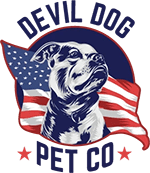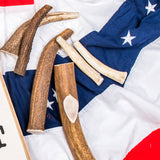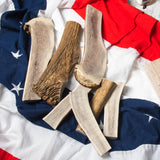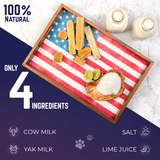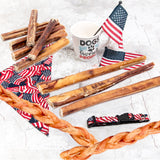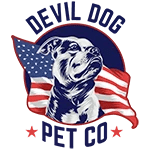Key Takeaways
- Split elk antler dog chews are made from naturally shed Rocky Mountain elk antlers cut lengthwise to expose nutrient-rich marrow that appeals to heavy chewers.
- The dense cortical bone structure of split elk antlers resists splintering and provides long-lasting durability for dogs with strong jaws.
- Choosing the right size split antler is crucial for safety and satisfaction, with recommendations based on the dog’s jaw length and weight class.
- Split elk antlers offer immediate flavor access and gentler tooth safety compared to whole antlers, which provide longer-lasting durability but require careful monitoring.
- Compared to other chews like bully sticks and rawhide, split elk antlers last significantly longer and reduce choking and dental risks for heavy chewers.
Table of Contents
- What Are Split Elk Antler Dog Chews?
- Why Split Elk Antler Chews Are Built for Heavy Chewers
- How to Choose the Right Split Elk Antler Chew for Your Heavy Chewer
- Split vs. Whole Elk Antler Chews for Heavy Chewers
- Split Elk Antlers vs. Other Top Chews: Which Outlasts and Protects?
- How to Safely Introduce and Supervise Split Elk Antler Chews
- Cleaning, Care, and When to Replace Split Elk Antler Chews
- Addressing Risks, Myths, and Common Problems (Heavy Chewers Edition)
- Best Dog Owner Practices for Extreme Leadership with Chews
- Where to Shop: Choosing Safe, Ethically Sourced Split Elk Antler Chews
What Are Split Elk Antler Dog Chews?
Split elk antler dog chews are natural chews made by cutting Grade-A Rocky Mountain elk antlers lengthwise to expose the nutrient-rich marrow inside. This exposed marrow delivers instant flavor and satisfaction for dogs, especially those with strong jaws and a high chewing drive. The dense outer bone resists splintering, making split elk antlers a safer, longer-lasting alternative to many commercial chews.
Download the FREE 10-Step Dog Prep Guide
Why Split Elk Antler Chews Are Built for Heavy Chewers

Elk antler bone matrix achieves density levels that dwarf most chew alternatives. The cortical bone structure resists splintering because elk antlers grow as solid, uniform tissue, not the hollow, layered composition found in processed bones. When heavy chewers attack split elk antler dog chews for heavy chewers, they encounter resistance that channels destructive energy into productive gnawing.
The exposed marrow triggers deep satisfaction in power chewers by rewarding their effort with rich, meaty flavor. Dogs that demolish bully sticks in minutes often gnaw split antlers for weeks because the dense outer wall forces methodical scraping rather than rapid consumption.
Your dog qualifies as a heavy chewer if they: destroy "indestructible" toys within hours, splinter rawhide into dangerous chunks, or chew furniture when bored. These behaviors signal a jaw strength and chewing drive that demands antler-grade durability.
How to Choose the Right Split Elk Antler Chew for Your Heavy Chewer
Size selection determines both safety and satisfaction. Choose a split antler at least 1.5 times your dog's lower jaw length, this prevents the chew from fitting between back molars where maximum bite force concentrates. For heavy chewers, bigger always wins: oversized antlers last longer and eliminate choking risks.
Weight provides a rough guide: 25-50 lb dogs need Large splits, 50-80 lb dogs require XL, and 80+ lb power chewers demand Monster or Beast sizes. When in doubt, size up, your heavy chewer's jaw strength likely exceeds their weight class.
Devil Dog Pet Co. offers photo sizing support: email a picture of your dog with their mouth open alongside a ruler, and our team provides custom fit recommendations. This service prevents the costly mistake of undersizing, which forces frequent replacements and increases safety risks.
Split vs. Whole Elk Antler Chews for Heavy Chewers
| Feature | Split Elk Antlers | Whole Elk Antlers |
|---|---|---|
| Longevity | 2-4 weeks for heavy chewers | 4-8 weeks for heavy chewers |
| Immediate Appeal | High (exposed marrow) | Moderate (flavor develops slowly) |
| Tooth Safety | Gentler (dogs lick/scrape marrow) | Harder (requires careful monitoring) |
| Best For | Flavor-motivated heavy chewers | Maximum durability seekers |
Heavy chewers benefit from splits when they need immediate engagement or show picky eating habits. The exposed marrow provides instant gratification that keeps aggressive chewers focused. Whole antlers suit power chewers who methodically work a single chew for months, making them cost-effective for patient, persistent gnawers.
For more on choosing the right size and style, see our guide on large split elk antler chews for dogs.
Split Elk Antlers vs. Other Top Chews: Which Outlasts and Protects?
 yak cheese, bully sticks, and folded flag at sunset.">
yak cheese, bully sticks, and folded flag at sunset.">
Yak cheese chews dissolve completely but last only 3-7 days with heavy chewers. They're fully digestible yet expensive per chewing hour. Bully sticks provide high protein but disappear in 20-30 minutes with powerful jaws, creating choking hazards as they soften.
Rawhide poses serious digestive risks when heavy chewers tear off large chunks, while nylon bones can crack teeth with their unforgiving hardness. Split elk antler dog chews for heavy chewers occupy the sweet spot: lasting weeks rather than minutes, naturally digestible in small amounts, and hard enough to satisfy without breaking molars.
Replace any chew when it shrinks to less than 2 inches or develops deep cracks. Watch for excessive drooling or pawing at the mouth, signs your heavy chewer may be overdoing it. Never combine multiple hard chews in one session, as this increases dental stress.
How to Safely Introduce and Supervise Split Elk Antler Chews
Start every heavy chewer with a 15-minute supervised session, regardless of their demolition history with other chews. Hold one end of the split antler while your dog investigates the marrow end, this prevents aggressive grabbing and teaches proper positioning. Praise calm, side-to-side gnawing motions and redirect any straight-down biting attempts.
Heavy chewers often attack new items with maximum intensity. Counter this by offering the antler only when your dog is already calm, after a walk or training session, not during high-energy moments. Remove the chew if your dog attempts to flip it vertically and bite down with full jaw pressure.
Establish your weekly "Antler Check Drill": examine the chew for cracks, measure remaining length, and assess wear patterns. Uneven wear indicates improper chewing technique, work on repositioning during supervised sessions. Deep grooves or channels suggest your dog is finding the right gnawing rhythm.
If your heavy chewer tries breaking off chunks rather than grinding gradually, the antler may be too small or too dry. Soak the antler in warm water for 5 minutes to restore slight flexibility, then supervise the next session closely. Persistent chunk-breaking behavior means transitioning to a larger size or switching to whole antlers temporarily.
Cleaning, Care, and When to Replace Split Elk Antler Chews
Clean split elk antler dog chews for heavy chewers with warm water and a stiff brush after each session, focusing on the marrow cavity where saliva and debris accumulate. Never use soap or chemicals, these can penetrate the porous marrow and cause digestive upset. Air-dry completely before storage to prevent bacterial growth in the exposed marrow channels.
Heavy chewers typically consume split antlers within 2-4 weeks, depending on session frequency and chewing intensity. A properly sized split antler should show gradual, even wear rather than sudden breakage. Monitor the marrow cavity, once it's completely hollowed out and the outer walls thin to less than half-inch thickness, retirement time approaches.
Replace immediately when the remaining piece measures shorter than your dog's muzzle length or develops cracks extending from the marrow to the outer surface. Sharp edges from aggressive chewing also signal replacement time. Don't attempt to "rehydrate" overly worn antlers, the structural integrity is compromised.
Store unused antlers in a cool, dry location away from direct sunlight. Properly stored Grade-A elk antlers maintain their hardness and nutritional value for over two years. Rotate between multiple antlers to extend the life of each piece, dogs often lose interest temporarily, then rediscover "forgotten" chews with renewed enthusiasm.
Addressing Risks, Myths, and Common Problems (Heavy Chewers Edition)

The biggest risk with split elk antler dog chews for heavy chewers isn't splintering, it's owners choosing undersized pieces. Grade-A elk antlers rarely splinter when properly sized, but a determined 80-pound customer's dog can reduce a Small antler to swallowable chunks within hours. Always size up for aggressive chewers, even if it seems excessive.
Myth Buster: "Split antlers are weaker than whole antlers." Reality: The splitting process doesn't compromise structural integrity. Poor-quality antlers from farmed elk or chemical processing create weakness, not the splitting itself.
Cracked teeth occur when dogs bite straight down with full pressure rather than gnawing from the side. Train proper technique during supervised sessions, hold the antler horizontally and redirect vertical biting attempts. If your heavy chewer consistently attacks chews aggressively despite training, consider softer alternatives like yak chews for daily use and reserve antlers for calm moments.
GI upset from antler consumption is rare but possible if dogs swallow large marrow pieces quickly. Rich marrow can cause loose stools in sensitive dogs. Start with 15-minute sessions and monitor bathroom habits for the first week. Most dogs adjust naturally as their digestive system adapts to the mineral content.
When heavy chewers finish split antlers too quickly, resist the urge to upgrade to larger sizes indefinitely. Instead, rotate between splits and whole antlers, or implement scheduled chew times rather than free access. This extends each chew's lifespan while maintaining enrichment value.
For more on safety and natural alternatives, you might also like our article on natural antler dog chews for tough chewers.
For additional information on antler safety, see this AKC guide on antlers for dogs.
Best Dog Owner Practices for Extreme Leadership with Chews
Extreme Dog Leadership means taking full responsibility for your dog's chewing success before problems develop. Inspect every split elk antler dog chews for heavy chewers weekly, measure remaining length, check for cracks, and assess wear patterns. You wouldn't let a Marine outgrow his boots; don't let your dog outgrow a chew.
Rotate chew types strategically rather than relying on one solution. Use split antlers for extended calm periods, bully sticks for training rewards, and yak chews for high-energy redirection. This rotation prevents boredom while managing different behavioral needs throughout the day.
Replace chews early, not late. The moment an antler reaches your dog's muzzle length or shows structural compromise, retire it immediately. This proactive approach prevents emergencies and demonstrates the leadership mindset that keeps dogs thriving in homes rather than surrendered to shelters due to preventable incidents.
Document what works for your specific dog, session lengths, preferred chew positions, and replacement timelines. This intelligence helps you optimize future purchases and creates a reliable system for pet sitters or family members. Consistent standards eliminate guesswork and maintain safety protocols regardless of who's supervising.
Where to Shop: Choosing Safe, Ethically Sourced Split Elk Antler Chews
Devil Dog Pet Co. sources split elk antler dog chews for heavy chewers exclusively from naturally shed Rocky Mountain elk antlers, never farmed or harvested. Each piece undergoes hand-inspection for density, proper splitting, and edge finishing before packaging. Our Grade-A standards ensure consistent hardness and marrow quality that aggressive chewers demand.
When evaluating suppliers, demand transparency about sourcing locations, processing methods, and quality control procedures. Reputable sellers provide clear information about elk populations, shed collection practices, and safety testing protocols. Avoid suppliers offering unusually cheap antlers, these often come from compromised sources or inadequate processing.
Every Devil Dog split antler includes detailed sizing guidance, safety instructions, and our Happy Tails Promise, no-questions-asked replacement if you or your dog aren't completely satisfied. We package each chew individually after final inspection, ensuring the piece that reaches your door meets our veteran-owned standards.
Ready to give your heavy chewer the durability they deserve? Shop Devil Dog Pet Co.'s premium split elk antler chews and experience the difference that ethical sourcing and rigorous quality control make for your dog's safety and satisfaction.
To learn more about the science of dog chewing, see this overview of dog chewing behavior.
For a deep dive into options for power chewers, check out our blog on jumbo split elk antler chews for power chewers.
Download the FREE 10-Step Dog Prep Guide
Frequently Asked Questions
What makes split elk antler dog chews more durable and safer for heavy chewers compared to other chew options like bully sticks or rawhide?
Split elk antler chews feature a dense, uniform bone structure that resists splintering, unlike rawhide or softer chews. Their exposed nutrient-rich marrow provides immediate flavor, encouraging focused gnawing that channels destructive energy productively. This durability and natural composition reduce choking hazards and dental risks common with bully sticks or rawhide, making them ideal for heavy chewers.
How do I choose the right size split elk antler chew to ensure safety and satisfaction for my heavy chewing dog?
Select a split antler longer than your dog's lower jaw and thick enough that it can't fit between their back molars. For heavy chewers, sizing up 1–2 levels from the baseline size chart improves safety and chew longevity. When in doubt, measure your dog’s jaw length or send a photo for expert sizing advice to ensure the chew fits properly and minimizes swallowing risks.
What are the differences between split elk antler chews and whole elk antler chews in terms of flavor access, durability, and tooth safety?
Split antlers expose nutrient-rich marrow, offering instant flavor that appeals to many dogs, especially puppies and seniors. They wear down faster than whole antlers but are gentler on teeth due to licking and scraping rather than crunching. Whole antlers last longer and are tougher but require careful supervision to prevent tooth cracks, as they demand more forceful chewing.
How should I safely introduce and supervise my dog when giving them split elk antler chews to prevent potential risks?
Start with a split antler by rubbing a small amount of peanut butter on the exposed marrow to spark interest. Hold one end and encourage calm gnawing during short, supervised sessions of 15–20 minutes. Always monitor your dog to prevent swallowing large shards, retire the chew when it becomes small or cracked, and consult your vet if you have concerns about your dog’s chewing style or dental health.
